Ever since I was 18, I have worked in the darkroom. Even long after most of my work changed over to digital and Lightroom, I developed the occasional roll of film. And I printed some of the images in the good old chemical process. Yet it seems that this part of my life is now over. I have had to say farewell to the darkroom.
To be honest, more often than not, I was not overjoyed to go to this place. The smallest possible darkroom you can think of. Room for the enlarger and three 8×10 inch developing trays. And me, and a safelight. No running water in the lab itself but outside in the equally windowless main room. No comfy place, but it was mine, and it was a place of magic. Magic soon unravelled after I started to work. Regardless of how much motivation I posessed (or lacked) at the outset, the mojo soon began to develop.
The reporter was expected to bring some photos, too
When still at school, I began to work for our local newspaper, the SÜDKURIER. This was in 1988, and part of my assignment was taking photos of more or less relevant events in town. It was all black and white back then in the late 80s, and I had to submit developed negatives. I could have processed them in the newsroom the morning after the assignment. But I had to be at school at that time, of course. So, I started to develop the Tri-Xs and HP5s on my own. A room without windows was available, and a processing tank was a manageable investment.
Soon I realized that it was better to hand in a print because, in this case, I could keep the film. Otherwise, they would have kept and “archived” the negative… my negative!. We had a darkroom in our school, and I learned how to make prints from older students. These “Foto-AGs” (photography clubs) were quite popular then. It is a pity that all the schools have long abolished their labs; another, in this case unemotional, farewell to the darkroom. They would certainly be popular again in the days of the analogue renaissance.
I was so lucky with my neighbour and his darkroom
But late in the evening, after coming home from the usual assembly, concert or whatever, I could not access the school lab. But I was fortunate to have a neighbour. He was a professional photographer, worked for a big industrial company and had a small darkroom in his basement. Sooner than later, I was trusted with a key and could walk in and out whenever I wanted. The only thing I had to do was bring my own paper and tidy up at the end (which, while in the lab, has become second nature to me since then).
Shortly after that initial foray into home development, my neighbour approached retirement. By this time, we had become quite friendly, and it was clear that he appreciated my enthusiasm. But I was shocked to hear that he wanted to quit everything related to photography on the very day he quit work. I would lose access to the small lab. Would I have to say farewell to the darkroom after I just started?
A Fujimoto G70 Computer enlarger, all my pride and joy
It ended with his giving the enlarger to me, a Fujimoto G70 Computer. This was pretty much the best money could buy in those days. It had microprocessor exposure control, all options for colour processes, including Cibachrome (anyone remember?) and both 135 and medium format masks. It came with two excellent Schneider Kreuznach Componon-S 50 and 100mm lenses.
Countless hours on two square metres
At the time, a very small storage closet in my parents’ house became available. My father helped me to transform it into a tiny darkroom. And countless were to be the hours and sometimes nights I came to spend in there. I printed my news photos, I printed my private work (mainly what is called “street photography” now, but also landscapes and architecture), I undertook experiments on colour processing, and I produced numerous Christmas presents there for friends: Calendars with twelve 5×7 inch prints of black-and-white photos I took over the year. I wonder if some of them have survived somewhere.
Farewell to the darkroom: An impossible thought for decades
The small lab remained pretty unchanged over the years, with no thoughts of saying farewell to the darkroom. Not generally, not to this one. I started to work as a journalist, always on the run, and found a nice distraction in the loneliness of the lab. I left my hometown, went to university in Berlin and came back to the lab during the term breaks. I settled into new jobs and felt myself perfectly at home away from my parents, but the lab remained familiar ground.
Going into this secluded place, arranging the three trays, mixing the chemicals, getting the enlarger ready, seeing the image emerge in the developer and smelling the sulphurous odour of the fixer made me feel comfortable. It felt as though I were far away from the world, yet, at the same time, right in the middle. I was, as we would say now, with myself.
Over the years, my visits to the lab went rarer, with my work commitments and family becoming more demanding. I gave up stocking paper and chemicals because I feared they would expire unused. No problem; my photo dealership, Lichtblick, here at Konstanz – always had what I needed readily available. Actually, they still do, as one of the last shops existant in Germany. They sell all the chemicals and papers to this day. Yet I bought new lab material only rarely. I felt something coming to an end.
Every now and then: Return to the darkroom, travel back in time
However, no visit to my mother’s went by without going downstairs to the lab. I looked at this beautiful enlarger, switched it on, and promised myself to resume lab work soon. Often, far too often, it remained an intention. But once a year or so, I travelled back in time and developed photos. Each time I realised that I was still quite good at it (the late nights paid off)… and that a handmade black and white print is simply wonderful.
When it became clear that my mother would soon give up the house, it was also decided that I would have to close the darkroom forever. And since I’m a bit theatrically inclined, I took on a final project. I made 7×9.5 inch (always a favourite size) prints of the films I exposed on a journey to Italy with my mother and turned them into a Christmas album. It turned out beautifully.
Yes, it was hard to say a final farewell to the darkroom
It didn’t make it any easier for me to say farewell to the darkroom. It was so nice to stand in the dull red light for a whole long day. The old radio on the shelf was still playing the station I used to listen to as a grammar school boy, and it was all very melancholy. I could have gone on like that for a long time, especially as I found a pack of Ilford Multigrade paper that I had bought 20 years earlier (another tick of mine: always write the date of purchase and date of opening on it). The prints made with the material were flawless and amazing.
One last time I ran the well-rinsed prints through the old Kindermann dryer; one last time, I cleaned my trays, carefully wiped my work surface (as if that still mattered), disassembled the enlarger — and felt infinitely sad. Such was the farewell to my darkroom. An important part of my life was over.
Final farewell to the darkroom? Or rather a “Auf Wiedersehen”?
Really? I have not yet given away the enlarger; I also kept a set of trays, the lab timer and the safelight. I do know where to source chemicals and paper. As I wrote here one year ago, the film processing era is not over for me; I can and will continue to develop negatives here at my place anyway. And “farewell to the darkroom” can also mean “Auf Wiedersehen”, can’t it? I’ve started to think about which room I could make lightproof here at home. I already have an idea…
Read more from Jörg-Peter Rau
Make a donation to help with our running costs
Did you know that Macfilos is run by five photography enthusiasts based in the UK, USA and Europe? We cover all the substantial costs of running the site, and we do not carry advertising because it spoils readers’ enjoyment. Every amount, however small, will be appreciated, and we will write to acknowledge your generosity.

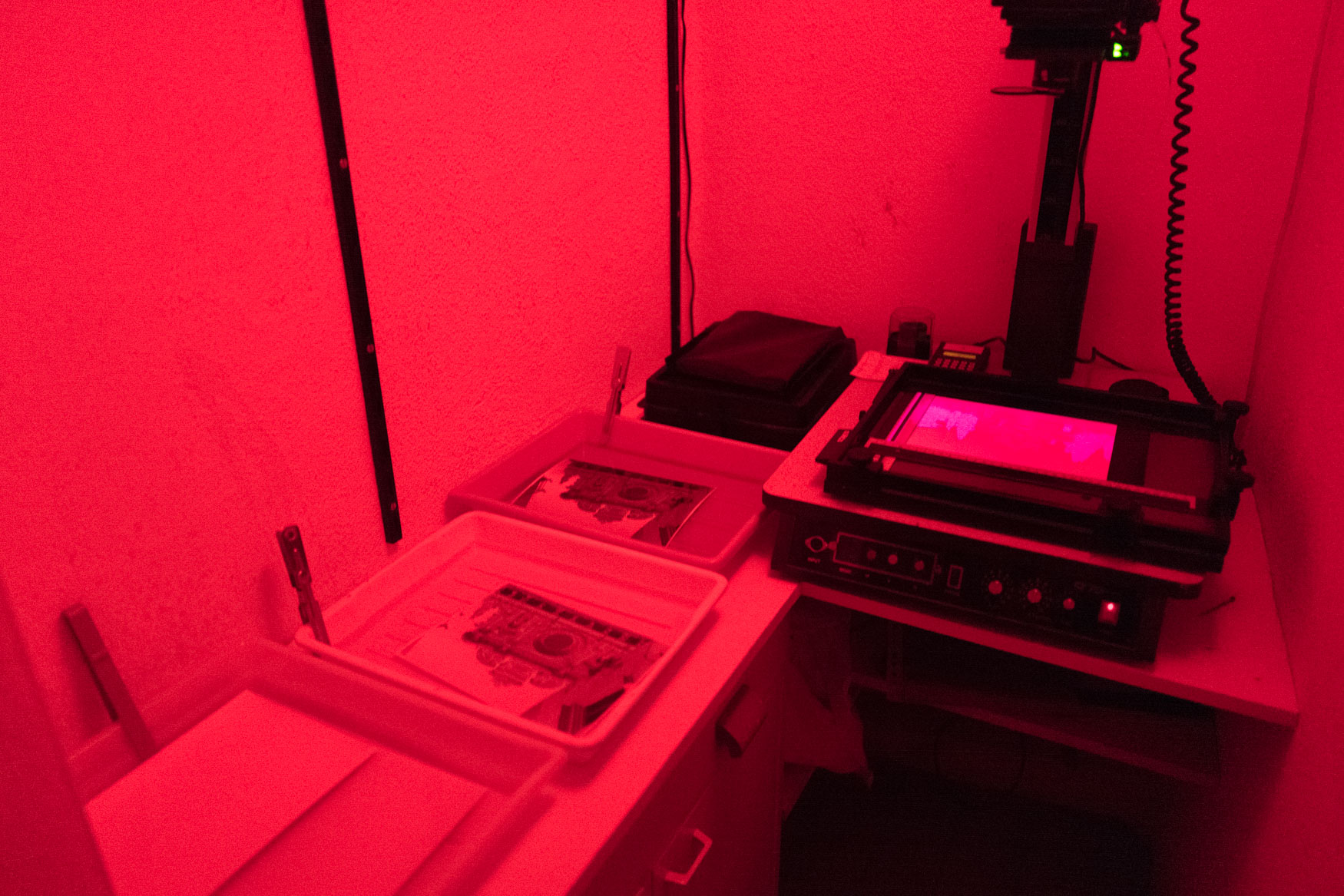
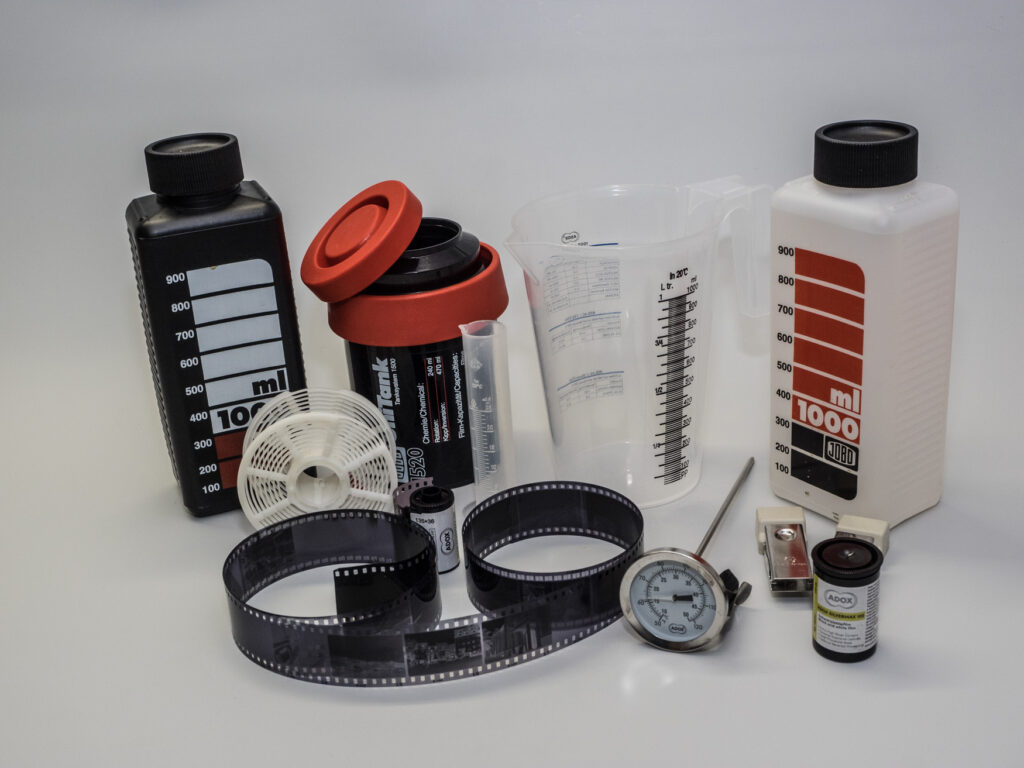
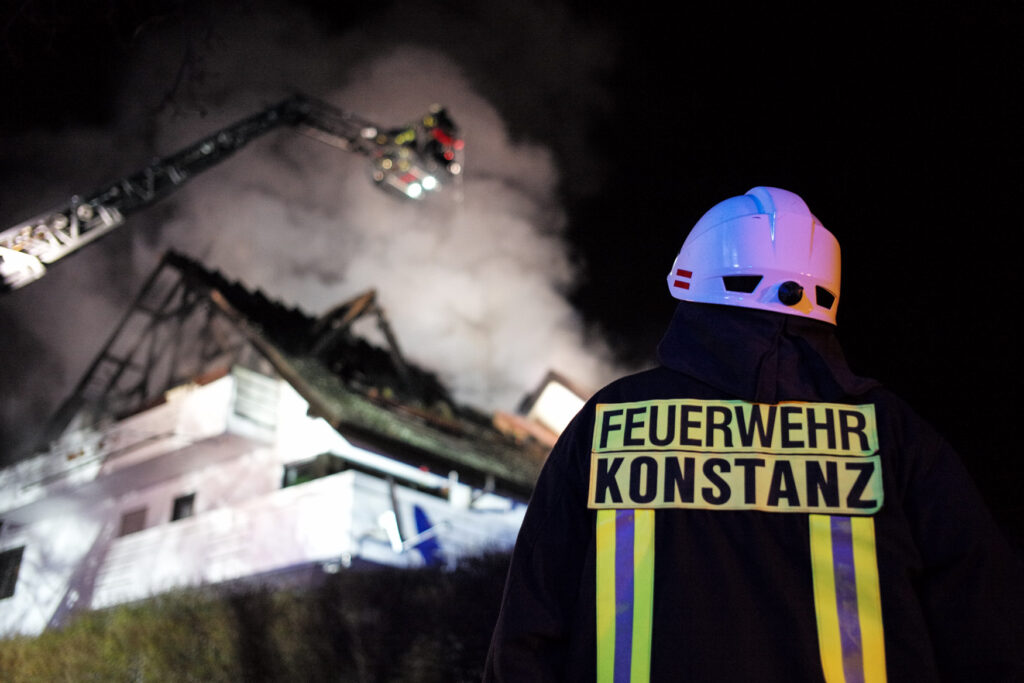
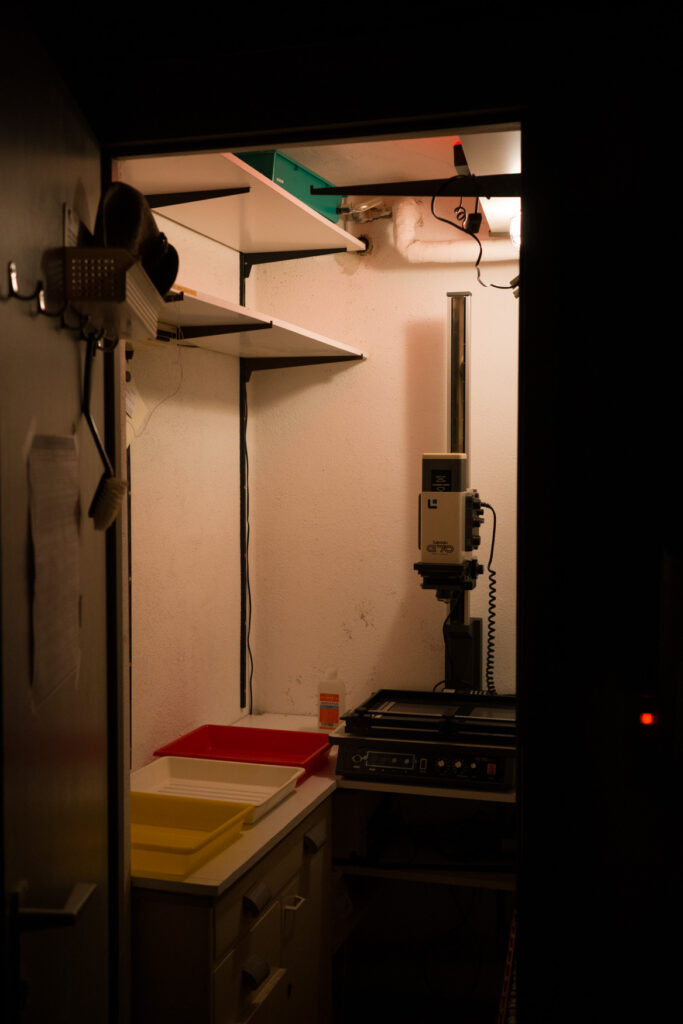
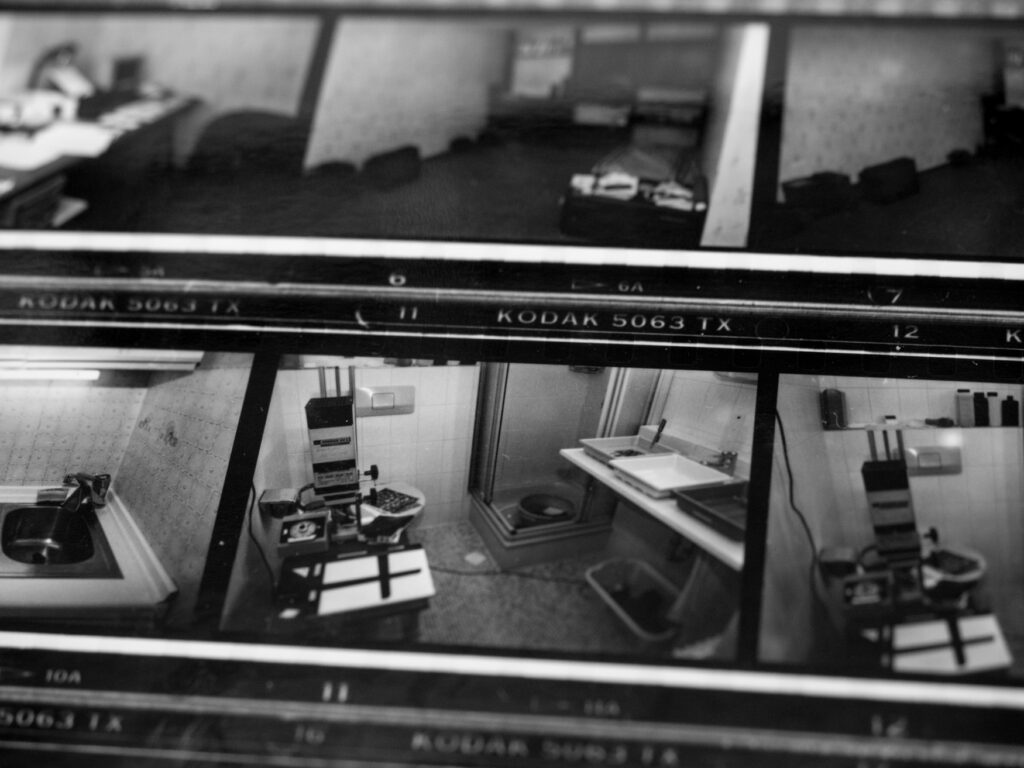
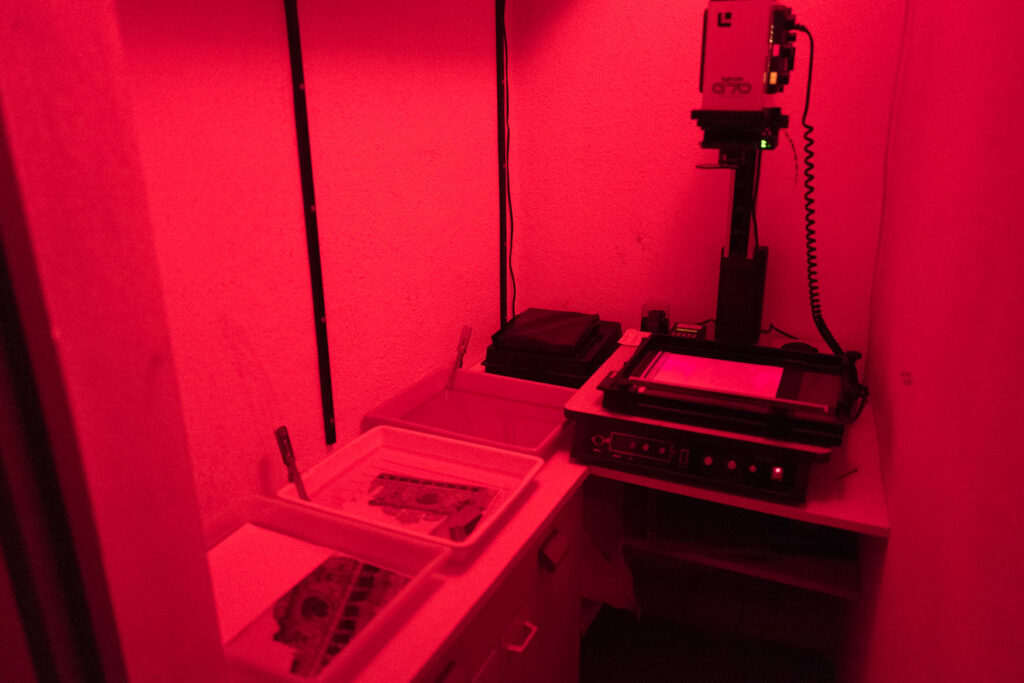
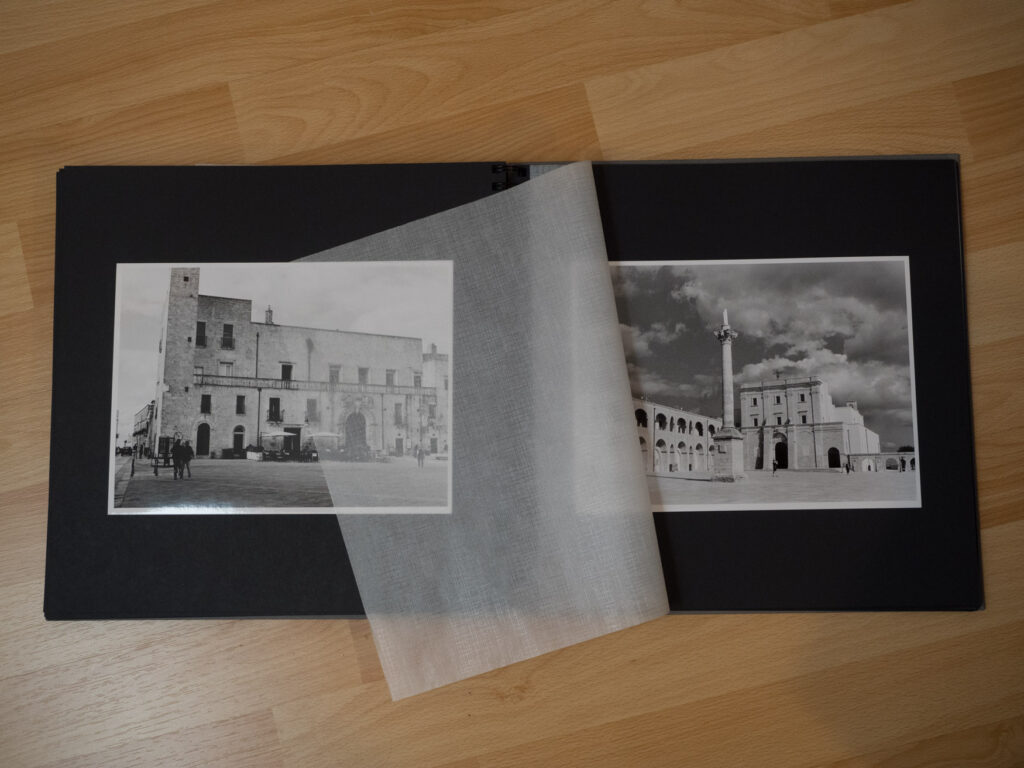
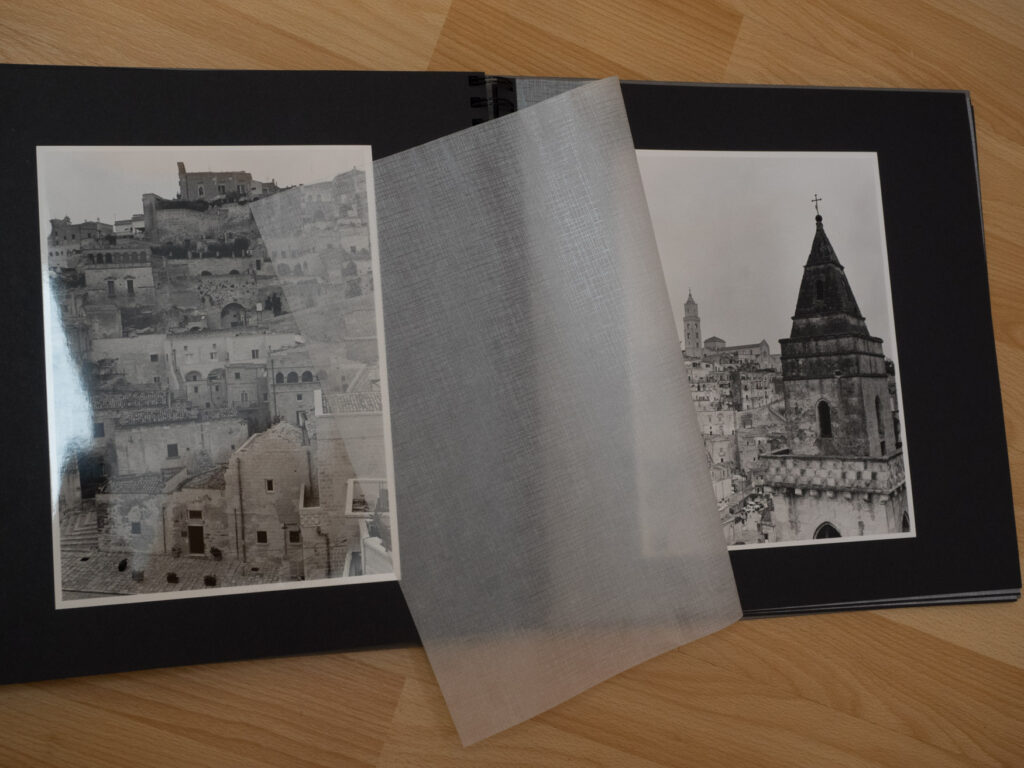
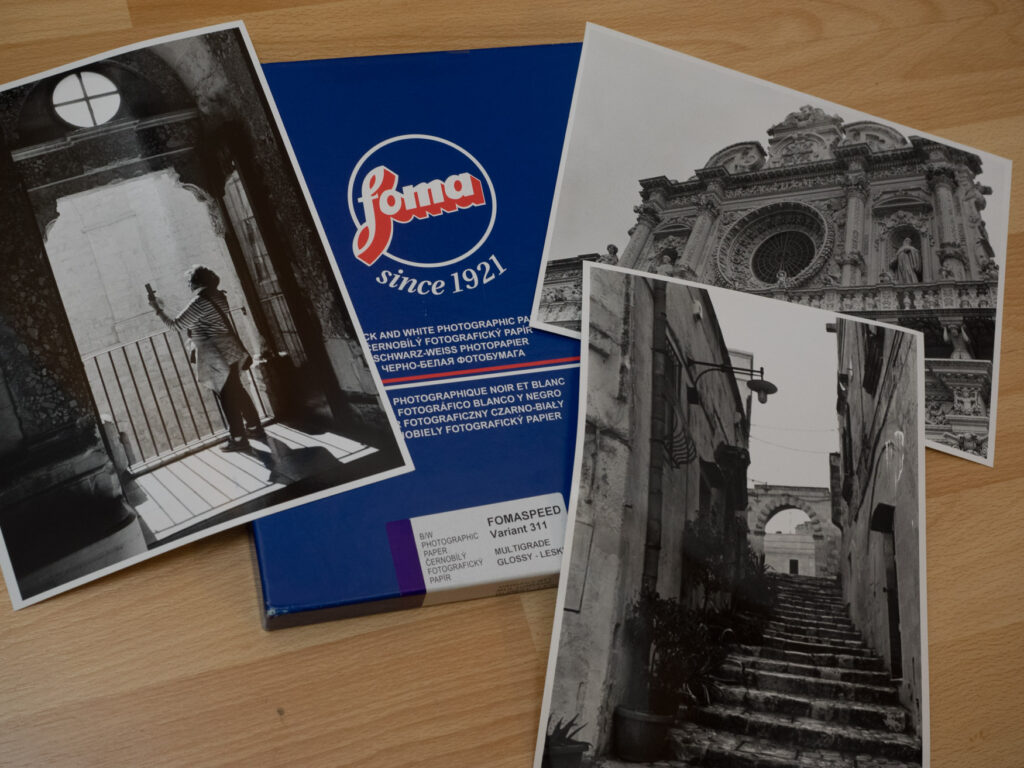
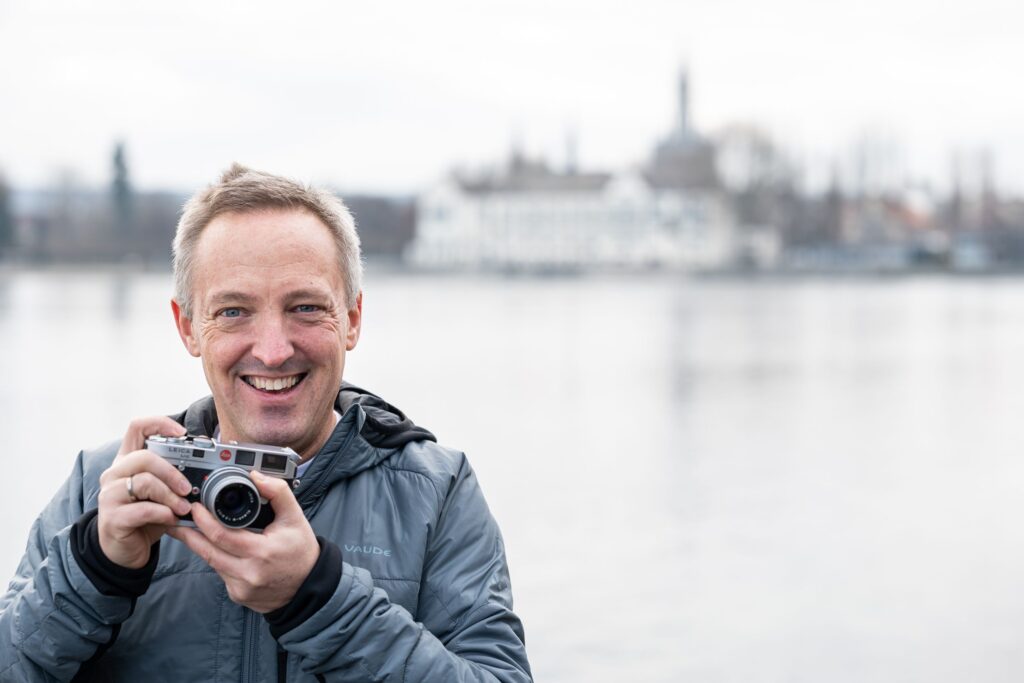
Hi,
Thank you for this article. I was a newspaper photographer for over 30 years, a job I loved. I recently gave a talk to children in the school where I now work about my photography career. I explained that it was the ‘magic’ moment when I saw a picture appear in the developing tray in a friend’s under the stairs make shift darkroom that inspired my career. There is something almost spiritual about hand creating and crafting a tangible print in a darkroom that digital will never replace. I feel privileged to have experienced that. It also marked you out as a photographer, it was a specific skill in it self. As for many photographers the convenience and comfort of the digital laptop has seduced me. Ironically, the ease and accessibility of digital has ultimately what has eaten away and made many of us redundant, sadly. I am just embarking on a project to create wet plate collodion images, in the hope that the ‘magic’ is still there.
Wow, William, what wonderful stories.
I must admit reading Macfilos lately has rekindled my interest in shooting film. Luckily I have a number of MF Nikkors and a couple F2s still in my inventory. (I have been using the MF Nikkors on my Df anyway).
But not the darkroom. Still have all the equipment (I need to sell) but no place to use it. And not enough time. So I did some research. All the consumer-oriented local labs only make prints from digital files. If you want film processed, you have to send off. But then … I found a lab 30 miles away that caters to serious amateurs. They do all processing and printing in-house, including silver-based emulsions. This is exciting.
There are a lot of younger people using second hand or reconditioned film cameras. For them digital photography is what they do with their smartphones, but film photography is something different for them. As somebody has pointed out, perhaps on another thread, film is now relatively expensive, but people tend to value the fact that this forces them to be take care about taking photographs, rather than adopting a scatter gun approach. Also there is a tactile reassurance with film which does not exist with digital and film images may indeed outlast their digital ‘cousins’. Of course, if Lightroom is your thing then it is easy to scan film images. This will still give you a film look. Two years ago I found 80 x 170 year old waxed calotype negatives which gave superb images when scanned. These will form the basis of an article for Macfilos when a donation process is completed. Readers here will be astonished with the quality of the images.
William
Absolutely right. I hear from dealers that young people are coming every day to buy second hand Nikons, Canons, Minoltas and the like. And film. Price is no obstacle (it wasn’t in the Polaroid/Instax hype either). Quite in contrary, exactly as William writes: The new film shooters come in and say that they want to try “real photography”… as real as it was almost 200 years ago already. I’m curious about your story, William! JP
Sounds great, Martin, bring the F2s to their natural habitat (it’s not the drawer). You will be richly rewarded, and the lab you are wirting about will be an excellent support. JP
JP, sorry for the delay in getting back to you. Your story is wonderful and mirrors many similar stories around the world. However, don’t forget that the most read story on Macfilos would not have existed if I had not brought a 70 year old film into a darkroom. I have been travelling a lot recently and that was why I missed your article last week
The day that this article was published I was ‘up my neck’ in snow visiting a darkroom from 1893 onwards in the Midlands of Ireland and I have been travelling again since. The 1893 Darkroom is in ‘original condition’ but not in ‘working condition’. It contains a lot of dangerous chemicals, which are no longer permitted, and some early equipment such as an electric enlarger from about 1904. The darkroom contains a note book where the photographer wrote down details of the photos he took in the 1890s plus also the darkroom tweaks he applied. You might be glad to hear that while he started out using a British Dallmeyer Rapid Rectilinear lens, he eventually migrated to a German Goerz lens. Goerz provided glass to Leitz, but they shifted to Schott not long after the Leica had been introduced. I can hear Mike thinking “why does he not write me an article on this?”. The answer to this is that I will when I can find the time – I’ve just finished a few minutes ago giving The National Museum of Ireland some advice on early Kodaks in a collection in the West of Ireland and earlier I was sending Mike some advice on photos taken at a distance of about 80 Kms over the sea. I will, however, email you some photos of what a 130 year old darkroom looks like and maybe they might give you the encouragement you need to go back in again. If the wardrobe full of now forbidden chemicals does not get you, nothing will. I have been asked to give a talk at the 1890s darkroom during the Summer about the techniques which a photographer might have used 130 years ago, based on his notebooks.
When I get over my cataract operation next week I fully intend to start shooting a lot of film again and to start using the darkroom where I developed the ‘Swiss Roll’. It is not at home, but in the business of a good friend of mine, without whose sage advice there would have been no ‘Swiss Roll’ story. I like producing nice photos, but I also like the processes and the looks of film. Do I detect something similar in your last paragraph above?
I will try to send you some photos before the weekend.
William
Dear William,
sorry for answering only now. A wonderful story, very encouraging. I will keep the basic gear for the darkroom, and of couse your wonderful images from the Irish Midlands are an encouragement. I am in awe what former generations of photographers have taken on: Heavy cameras, high cost, high risk of failure, uncomfortable labs to say the least, dangerous chemicals… And yet they left us so many great images. Today, it is so easy to make a technically excellent picture, but there are so many bad images around. That much for “progress”. And as to “magic”: the Swiss roll is the best proof that it exists indeed.
All the best for you, Jörg-Peter
Thanks Jörg-Peter. In my travels moving from city to city and country to country, I never really felt I had a base where I could install a light room and maintain it to properly develop the habit and skills needed. Today it’s a simpler process but with less “craft” involved in developing images.
BTW. Did Roxanne help you switch off the red light?
You got the allusion, LeChef, a song that was already around at the time when I embarked on my photography adventure. JP
Joerg-Peter, a beautiful article. I could write one myself, as long, but not as eloquent. So I will abbreviate.
Being older than you, I started a B&W darkroom in 1967, a makeshift affair in a closet in an apartment rented while at university.
Darkroom #2 was custom built (by me) in the first house I owned, in 1974. The upper half of three walls was finished in pegboard, so I could hang anything anywhere. I only had a cheapo Bogen enlarger, with a cheapo lens for 120 negatives, but for 35mm I made an adapter to mount my Micro-Nikkor 55mm f3.5. Since it is a flat-field lens made for close distances, it is actually ideal an enlarging lens.
At this lab, in addition to occasional B&W, I did E-4, E-6, C-41, and whatever the processes were (I forget the names) for color prints from color negatives, and reversal prints from slides. Never did Cibachrome myself, but did do some in a rental lab.
Darkroom #3 was another makeshift one in a storeroom during the early matrimonial years. Only B&W, as I recall.
Darkroom #4 was another custom one I built myself, in the first house my wife and I owned. It was deluxe: Had a custom sink and cabinets, a power ventilation system, built-in safelights connected to the enlarger timer, and the pièce de résistance, a sliding pocket door that was light-tight. Equipment was state-of-the art as well, with a Beseler 23CII replacing the Bogen.
Alas, when we moved, I had to give that up. That was way back in 1986. For years I was “eventually going to” build a fifth one where we live now (continuously since 1987), but that never happened. Too many work and family responsibilities. I had to be content with slide film and commercial processing. However, I finally did build my custom workshop, where I pursue my other hobby, miniature machining. Occasionally combine the two hobbies, machining pieces for cameras. But that is another story.
Dear Martin, thanks for sharing your story. Sound as if you have collected a lot of experience in your various darkrooms. And great to read that you have now another place where you can pursue your hobby and train your skills. The “machining pieces for cameras” sounds interesting – maybe you want to tell about this here on Macfilos? Our Editor is always happy to receive suggestions for articles (and very helpful when it comes to fine tuning). JP
I said goodbye to my darkroom years ago when film photography was in clear decline, but I kept tanks and light tight bag for processing film. So I keep regularly shooting and developing black and white film. I don’t regret of that decision. Papers are expensive and still there’s a lot of nostalgia in many aspects of photography. Getting great results in a chemical lab requires special skills I never had. Digital prints evolved since then, when I started with a huge Epson printer getting nuts every time I wanted a good b@w print. Now great photographers make digital prints for their exhibits from their negatives. Nothing will replace the time spent in a darkroom though; the mystery and magic of appearing images has no equal in computer work. But it’s not that what actually photographs are made of, but of black and white and red and blue and yellow
Agree, George,
digital prints from (well!) scanned negatives can turn out excellent. For me, the fascination of the lab was more caused by the idea of mastering the complete process chain. It if only were for the results, a fully digital or hybrid workflow would have been the better option for years now. And yes, photographs are basically made of “black and white and red and blue” – but the are also made of the aforementioned process chain and the creative input that goes into every step of this process. I have the feeling that such steps are more accessible when they have analogue character (darkroom vs. Lightroom) because your learning curve of cause and effect is steeper. But this may just be my opinion.
All the best and thanks for your feedback, JP
I have been wrestling with this myself. My current wet darkroom was purpose built in 1992 when we moved to Tennessee. I still shoot Tri-X and keep floating lid tanks full of D76 and Kodak fixer from which I draw to process the film. A tank of Dektol awaits printing paper exposed on a Leitz IIC enlarger. With the addition of an M240 camera body, I find that my M6 use has slowed down a bit. Even with the current use of film, I tend to process the film, then scan into lightroom via a Leitz BEOON copy stand (using a 50mm APO Rodagon N enlarging lens to copy 35 mm negatives and a 80mm Schnieder Componon-S for my 120 film. Epson P700 does most of my printing. At some point I may dispense with the printing and processing in chemical trays, but for the moment there is still some magic left in watching the image emerge from the paper the old fashion way. We shall see …
That’s great, Jack, I hope you will experience a lot of pleasure in the darkroom for a long time to come. Tri-X will remain my favourite, it has the most beautiful grain I know. And if I really need (or, rather, believe to need) grain-less images at ISO 6400 or whatever, there is the M10M. Technologically perfect but not with the appeal of analogue black-and-white photography (to me at least). JP
I too have been wrestling with this. I don’t have running water in my darkroom so it’s off to the bathroom to wash the prints. I enjoy it but sometimes do find it tiring. I like others still shoot film – Tri-X and develop in D76. I like the process and I also scan with a Leitz BEOON copy stand. I see there are a few of us scanning this way too. I often find myself comparing prints from the darkroom compared to my Epson prints. It can be close but not the same and I guess this is why I continue to print in the darkroom. A great article by Joerg-Peter and I’ve really enjoyed reading all the comments too. I’d be interested to hear how you scan with you Leitz BEOON and the 50 APO Rodagon N enlarging lens? Currently I use a 50mm Summicron. Can you please point me in the right direction Jack. Thanks
I never did any, you guys make me jealous. That’s an Art Form bordering on the magical, my hat is off to all of you.
Thanks, John, but in the end it’s mainly about craftsmanship. More a matter of routine than of talent (which is, as everywhere, helpful). JP
I never got beyond doing contact prints from 620 film from my Brownie E box camera. And a cleared shelf – each time! – in the family “pantry” had some of the magic of your little lab. Getting a film developed by the shop was much cheaper than having prints done, so this was a way of making my pocket-money stretch further! Thank you for sharing your walk down memory lane.
I keep getting a message that I’ve already said that: I haven’t !!
Very clever, John. I remember the price structure was the same in Germany. Film processing was quite cheap, prints were expensive. For me, however, it was more a matter of speed, I needed to have the print for a late evening assignment the next morning. So I had no choice and did it all myself… JP
I never got beyond doing contact prints from 620 film from my Brownie E box camera. And a cleared shelf – each time! – in the family “pantry” had some of the magic of your little lab. Getting a film developed by the shop was much cheaper than having prints done, so this was a way of making my pocket-money stretch further! Thank you for sharing your walk down memory lane.
What a nostalgic biographical story, Joerge-Peter. It caused me to reflect on the many darkrooms I set up, many in the most unlikely places, like shower rooms and bedrooms. For several, I had to wait until it was naturally dark, lacking suitable black-out curtains. However, on balance, I enjoy the increased versatility and effectiveness of my digital darkroom, which I call my Light-room. How fortunate you were to have a professional photographer as your boyhood neighbour. It could have turned out radically different for you otherwise.
Very true, David, I owe Franz F. so much more than a beautiful enlarger. I will not forget him, even if the darkroom is not my magic place any more. JP
Hi Joerg-Peter, what a lovely, albeit sad tale! I can tell that closing down the darkroom was one of those significant ‘life-events’ for you. How wonderful though that you would able to mark the event in style with a beautiful photo album. I do not have a history in developing film or prints, but your story did remind me of some printing I undertook as a grad student in the college darkroom.
Somehow, I was in possession of negatives from photos taken at my parent’s wedding, in 1950, one of which showed my four grandparents in a group shot. It was a real thrill seeing the image float into view in the developing tank! I also remember heading home afterwards on a freezing cold evening, my bike covered in a glistening film of ice crystals. They images that stick in your memory, eh?
If ever I were to spring for a Leica M of some kind, I think it would be a film camera, so that it would likely still be usable by future generations – assuming these will always be a devoted band of film photographers in existence, and a supply chain to deliver the kit and caboodle required to process them. All the best! Keith
Dear Keith,
it’s a bit sad indeed, but life goes on, and parting with a darkroom is not the hardest moment you can think of. It’s amazing that so many Macfilos readers have either similar experience or a clear feeling what such a turning point means. I in turn understand perfectly well what you are writing about your bike ride in this special night.
This is seriously a community of like-minded people! It’s great to be here. All the best to you an all our readers,
JP
Thanks Joerg-Peter that took me down memory lane. I gave my enlarger 15 years ago. I could smell the chemicals while reading your article. Although my camera dealer still stock chemicals and paper I have not been tempted to go back to the darkroom. Lightroom has made things so easy but less magical.
Jean
You’re welcome, Jean. I understand you completely and take it as a compliment that you even had an olfactory sensory perception…. JP
Thanks for your article, Jorg-Peter. Wonderful that you found a meaningful way to mark this emotional farewell.
I started working in a darkroom age 14/15 and only stopped about five years ago (nearly 50 years later). I realised that I had much greater flexibility and control working in Lightroom and using a Leica M10M for black and white. Also, supplies were getting more and more expensive plus I questioned the use of so much water, especially for washing fibre-based paper archivally. I do miss it, however, especially for the sensorial aspects and, for decades, I had processed films and prints practically daily.
I gave all of the ‘bits and bobs’ to art students. My beloved enlarger was the very last version of the Focomat 1C-Colour with tall column, grey paint and white baseboard. When I discovered that an example of this type was not held in the Leica factory archives, I donated it.
I have kept only the 50mm f4.5 Focotar-2 (a fabulous enlarging lens) and use it for making 1:1 digital copies of negatives and transparencies. I then work with the large DNG files in Lightroom and this brings joy. I can still spend hours perfecting an image and do obtain superior results to what was possible in the darkroom.
Very best,
Frank
Dear Frank, I agree that Lightroom gives more options than the darkroom. And it’s better for the environment and (often) for your wallet. I am very happy to read that you passed your knowledge to the next generations. A good contribution to future! I hope the chemical process will never entirely die out: It’s not only part of my insignificant biography but a core element of photographic history and culture after all. But there is hope – some steam locomotives are running to this day as well. All the best and thanks for you kind feedback. Jörg-Peter
Wie Geht’s JP. I’m sure your prints are even more stunning when seen in person rather than in picture. In Europe, Chromogenic prints are another available option rather than wet prints. I’m still rather new to film though these days my output is about 80-90% dependent on B&W film. I have not advanced to darkroom printing but have become rather proficient with self development to the extent i dabble in N plus development. Darkroom printing if I advance into it seems another hurdle. I don’t foresee myself buying a digital Leica, and have in fact ordered a new MP to accompany my M-A. Black and white film images do indeed posses a certain indescribable je ne sais quoi. Thank you for sharing your experiences; the pleasure of creating a darkroom print is successfully communicated in your article. Perhaps someone like you with your vast experience and knowledge could be a heaven-sent to those around you especially the younger generation who wish to pursue darkroom printing. Practical experience is hard to come by. I steer clear of HP5 because of its grain qualities and tend to stick to Tri X 400 and Delta 100. Thank you again JP. By the way, although I purchased a 50mm summicron recently I also bought a Zeiss 35mm F1.4 after rereading your M files innumerable times. I’m fine with the size. But what image quality ! Especially with colour. Long live the M Files !
Hi Gireesh, great to read that you profit fom reading Macfilos. I wish you all the best for your further photographic journey. It’s magic – not only, but also in the darkroom. JP
Hi Jorg-Peter, That is an excellent story, and thank you for sharing. The prints looked great. I do miss processing my film. As you say, the ambience of a dark room, the smell of chemicals and the joy of seeing a print appear in the tray. I reluctantly gave up mine in 2008 when I went digital. Still take film but send it off for processing as we moved house, and I got rid of all my darkroom equipment.
Cheers
Jack
Thanks, Jack, for your kind feedback. I see I am not alone with my farewell to the darkroom. If you miss processing your film, read my article which is linked in the last paragraph. It’s neither difficult nor expensive to take it up again. The harder part is to get decent scans if you need them. All the best. JP